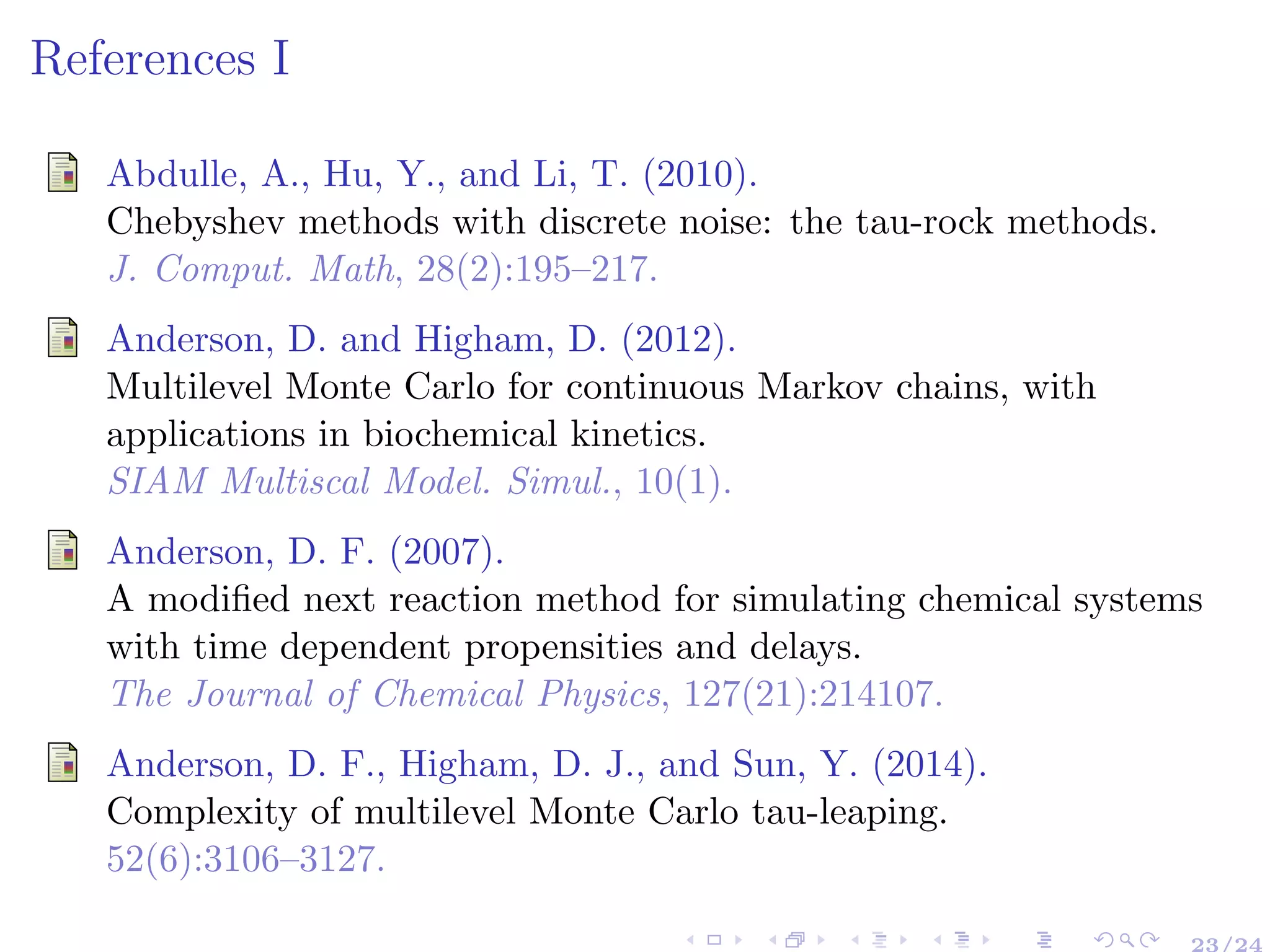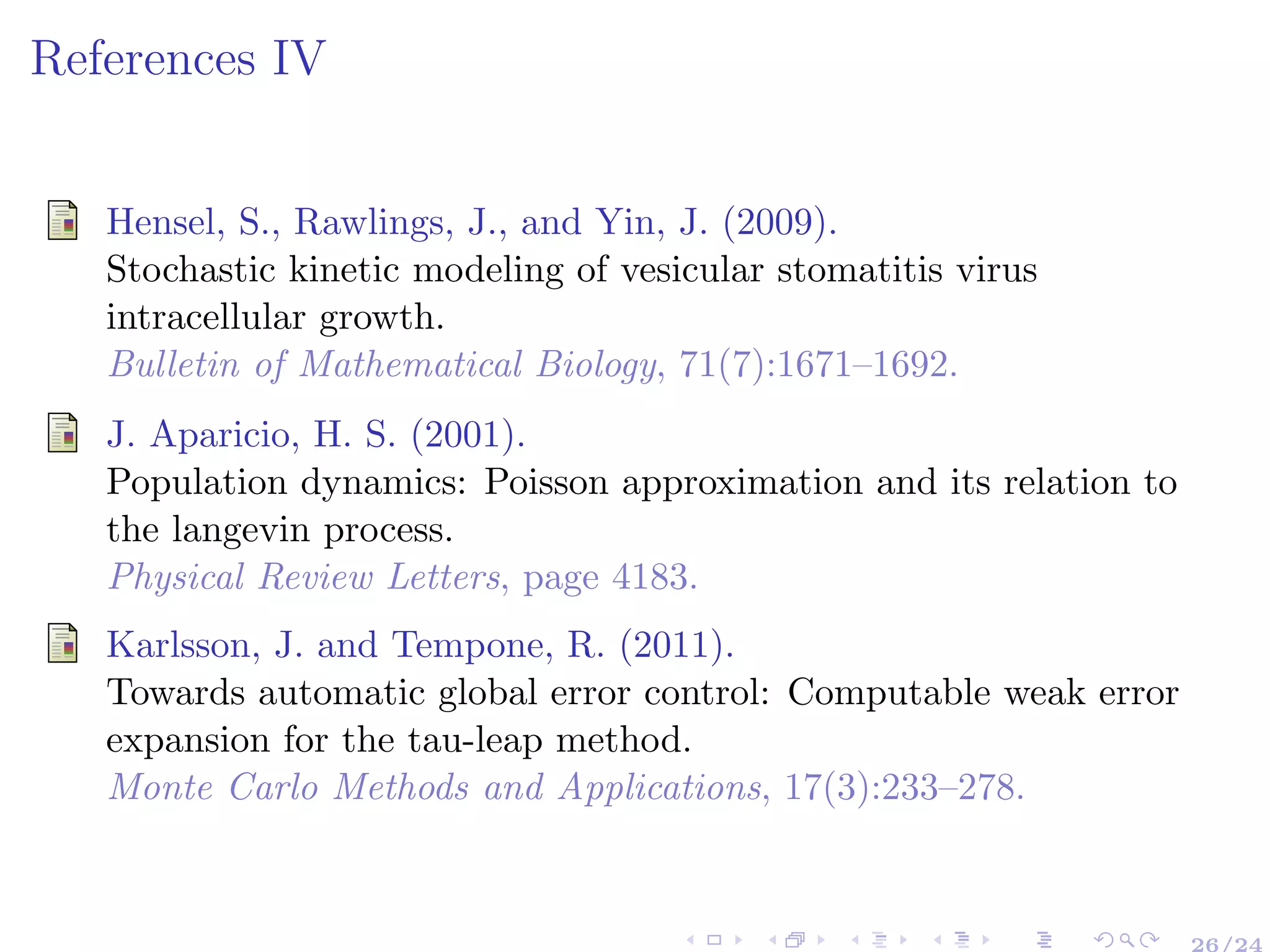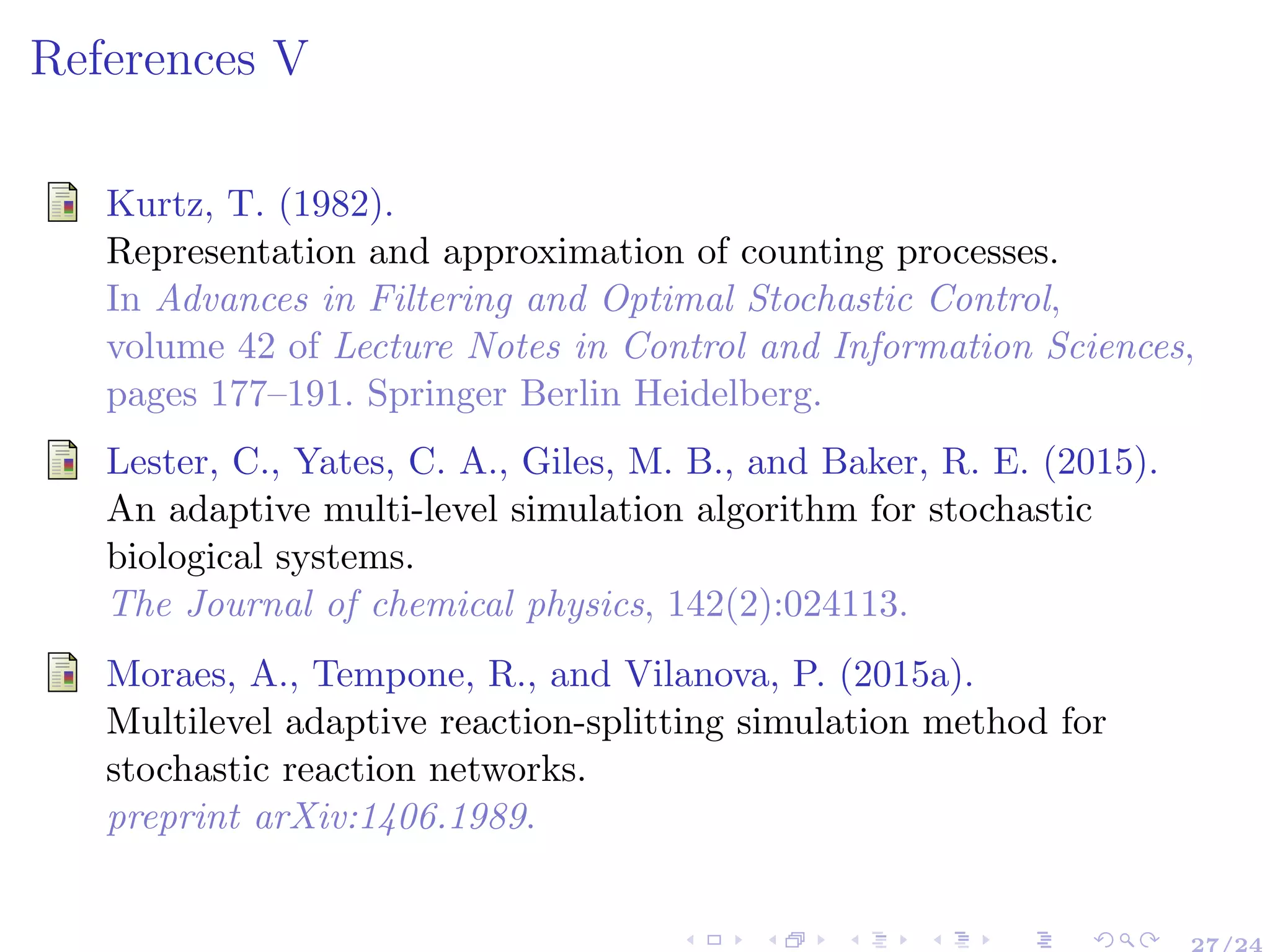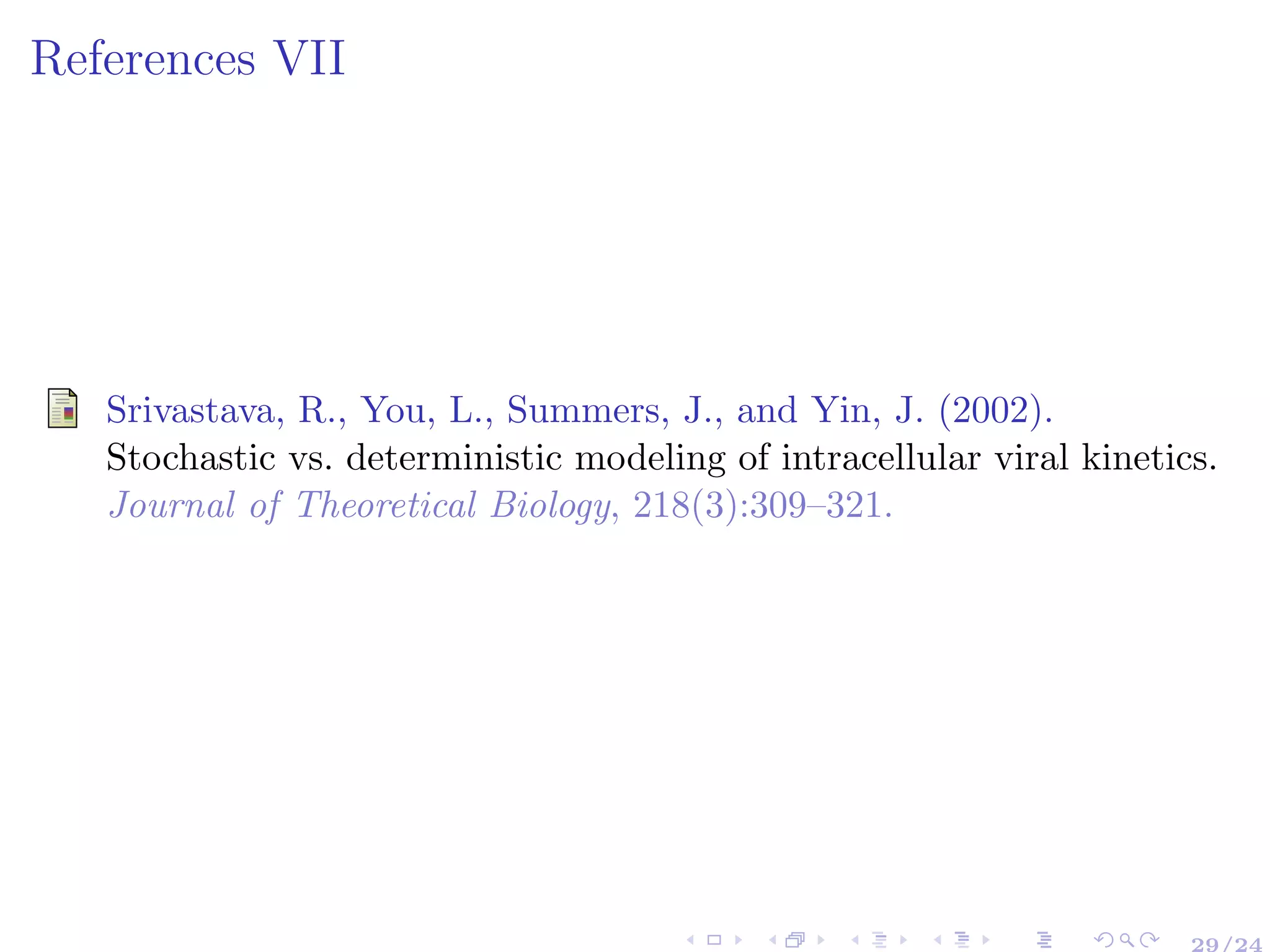The document discusses a multilevel hybrid split step implicit tau-leap (ssi-tl) method for estimating expectations in stochastic reaction networks (SRNs), focusing on systems with fast and slow time scales. It outlines the motivation, methodology, and numerical results comparing the performance of the ssi-tl method against traditional methods, demonstrating significant computational efficiency. Key findings illustrate that the hybrid estimator greatly outperforms the multilevel explicit tau-leap method in terms of expected computational work.


![SRNs applications: epidemic processes [Anderson and Kurtz, 2015]
and virus kinetics [Hensel et al., 2009],. . .
Biological Models
In-vivo population control: the
expected number of proteins.
Figure 1.1: DNA transcription and
mRNA translation [Briat et al., 2015]
Chemical reactions
the expected number of molecules.
Figure 1.2: Chemical reaction
network [Briat et al., 2015]
3/24](https://image.slidesharecdn.com/mcqmctalk-190712144530/75/Mcqmc-talk-3-2048.jpg)
![Statement of the Forward Problem
A stochastic reaction network (SRN) is a continuous-time Markov Chain X
defined on a probability space (Ω, F, P)
X = (X1, . . . , Xd) : [0, T] × Ω → Zd
+
described by J reactions channels, Rj := (νj, aj), where
νj ∈ Zd
+: stoichiometric vector (state change vector)
aj : Rd
+ → R+: Propensity (jump intensity) functions such that
P X(t + ∆t) = x + νj X(t) = x = aj(x)∆t + o (∆t) , j = 1, . . . , J. (1)
Goal: Given i) an initial state X0 = x0, ii) a smooth scalar observable of X,
g : Rd → R, iii) a user-selected tolerance, TOL, and iv) a confidence level 1 − α
close to 1, provide accurate estimator ˆQ of E [g(X(T))] such that
P E [g(X(T))] − ˆQ < TOL > 1 − α, (2)
with near-optimal expected computational work and for a class of systems
characterized by having simultaneously fast and slow time scales (Stiff systems).
4/24](https://image.slidesharecdn.com/mcqmctalk-190712144530/75/Mcqmc-talk-4-2048.jpg)
![Statement of the Forward Problem
A stochastic reaction network (SRN) is a continuous-time Markov Chain X
defined on a probability space (Ω, F, P)
X = (X1, . . . , Xd) : [0, T] × Ω → Zd
+
described by J reactions channels, Rj := (νj, aj), where
νj ∈ Zd
+: stoichiometric vector (state change vector)
aj : Rd
+ → R+: Propensity (jump intensity) functions such that
P X(t + ∆t) = x + νj X(t) = x = aj(x)∆t + o (∆t) , j = 1, . . . , J. (1)
Goal: Given i) an initial state X0 = x0, ii) a smooth scalar observable of X,
g : Rd → R, iii) a user-selected tolerance, TOL, and iv) a confidence level 1 − α
close to 1, provide accurate estimator ˆQ of E [g(X(T))] such that
P E [g(X(T))] − ˆQ < TOL > 1 − α, (2)
with near-optimal expected computational work and for a class of systems
characterized by having simultaneously fast and slow time scales (Stiff systems).
4/24](https://image.slidesharecdn.com/mcqmctalk-190712144530/75/Mcqmc-talk-5-2048.jpg)
![Simulation of SRNs
Pathwise-Exact methods:
Stochastic simulation algorithm (SSA) [Gillespie, 1976].
Modified next reaction algorithm (MNRA) [Anderson, 2007].
Pathwise-approximate methods:
Explicit tau-leap [Gillespie, 2001, J. Aparicio, 2001].
Drift-implicit tau-leap (explicit-TL) [Rathinam et al., 2003b].
Split step implicit tau-leap (SSI-TL)[Ben Hammouda et al., 2016].
5/24](https://image.slidesharecdn.com/mcqmctalk-190712144530/75/Mcqmc-talk-6-2048.jpg)
![Motivation and Contribution
MLMC estimator using explicit TL [Anderson and Higham, 2012].
In systems characterized by having simultaneously fast and slow
time scales, exact methods and the explicit-TL method can be
very slow and numerically unstable.
We propose in [Ben Hammouda et al., 2016] an efficient MLMC
method that uses SSI-TL approximation at levels where the
explicit-TL method is not applicable due to numerical stability
issues.
6/24](https://image.slidesharecdn.com/mcqmctalk-190712144530/75/Mcqmc-talk-7-2048.jpg)
![The Explicit-TL Method
[Gillespie, 2001, J. Aparicio, 2001]
From Kurtz’s random time-change representation
X(t) = x0 +
J
j=1
Yj
t
t0
λj(X(s))ds νj,
where Yj are independent unit-rate Poisson processes, we obtain the explicit-TL
method (kind of forward Euler approximation): Given Zexp(t) = z ∈ Zd
+,
Zexp
(t + τ) = z +
J
j=1
Pj
aj(z)τ
λj
νj,
Pj(λj) are independent Poisson random variables with rate λj.
Caveat: The explicit-TL is not adequate when dealing with stiff problems (
Numerical stability ⇒ τexp
threshold 1.)](https://image.slidesharecdn.com/mcqmctalk-190712144530/75/Mcqmc-talk-8-2048.jpg)


![Multilevel Monte Carlo by Giles [Giles, 2008]
Goal: Reduce the variance of the standard Monte Carlo estimator.
A hierarchy of nested meshes of the time interval [0, T], indexed by
= 0, 1, . . . , L.
h = M− h0: The size of the subsequent time steps for levels ≥ 1 , where
M>1 is a given integer constant and h0 the step size used at level = 0.
Z : The approximate process generated using a step size of h .
Consider now the following telescoping decomposition of E [g(ZL(T))]:
E [g(ZL(T))] = E [g(Z0(T))] +
L
=1
E [g(Z (T)) − g(Z −1(T))] . (5)
By defining
ˆQ0 := 1
N0
N0
n0=1
g(Z0,[n0](T))
ˆQ := 1
N
N
n =1
g(Z ,[n ](T)) − g(Z −1,[n ](T)) ,
(6)
we arrive at the unbiased MLMC estimator, ˆQ, of E [g(ZL(T))]:
ˆQ :=
L
=0
ˆQ . (7)
10/24](https://image.slidesharecdn.com/mcqmctalk-190712144530/75/Mcqmc-talk-11-2048.jpg)
![Multilevel Hybrid SSI-TL I
Our multilevel hybrid SSI-TL estimator is defined as:
ˆQ := ˆQLimp
c
+
Lint−1
=Limp
c +1
ˆQ + ˆQLint +
L
=Lint+1
ˆQ , (8)
where
ˆQLimp
c
:= 1
N
i,L
imp
c
N
i,L
imp
c
n=1
g(Zimp
Limp
c ,[n]
(T))
ˆQ := 1
Nii,
Nii,
n =1
g(Zimp
,[n ](T)) − g(Zimp
−1,[n ](T)) , Limp
c + 1 ≤ ≤ Lint − 1
ˆQLint := 1
Nie,Lint
Nie,Lint
n=1
g(Zexp
Lint,[n]
(T)) − g(Zimp
Lint−1,[n]
(T))
ˆQ := 1
Nee,
Nee,
n =1
g(Zexp
,[n ](T)) − g(Zexp
−1,[n ](T)) , Lint + 1 ≤ ≤ L.
(9)
11/24](https://image.slidesharecdn.com/mcqmctalk-190712144530/75/Mcqmc-talk-12-2048.jpg)

![Explicit-TL/Explicit-TL Coupling (Idea)
[Kurtz, 1982, Anderson and Higham, 2012]
To couple two Poisson random variables, P1(λ1), P2(λ2), with rates λ1 and
λ2, respectively, we define λ := min{λ1, λ2} and we consider the
decomposition
P1(λ1) := Q(λ ) + Q1(λ1 − λ )
P2(λ2) := Q(λ ) + Q2(λ2 − λ )
where Q(λ ), Q1(λ1 − λ ) and Q2(λ2 − λ ) are three independent Poisson
random variables.
We have small variance between the coupled processes
Var [P1(λ1) − P2(λ2)] = Var Q1(λ1 − λ ) − Q2(λ2 − λ )
=| λ1 − λ2 | .
Observe: If P1(λ1) and P2(λ2) are independent, then, we have a larger variance
Var [P1(λ1) − P2(λ2)] = λ1 + λ2.](https://image.slidesharecdn.com/mcqmctalk-190712144530/75/Mcqmc-talk-14-2048.jpg)
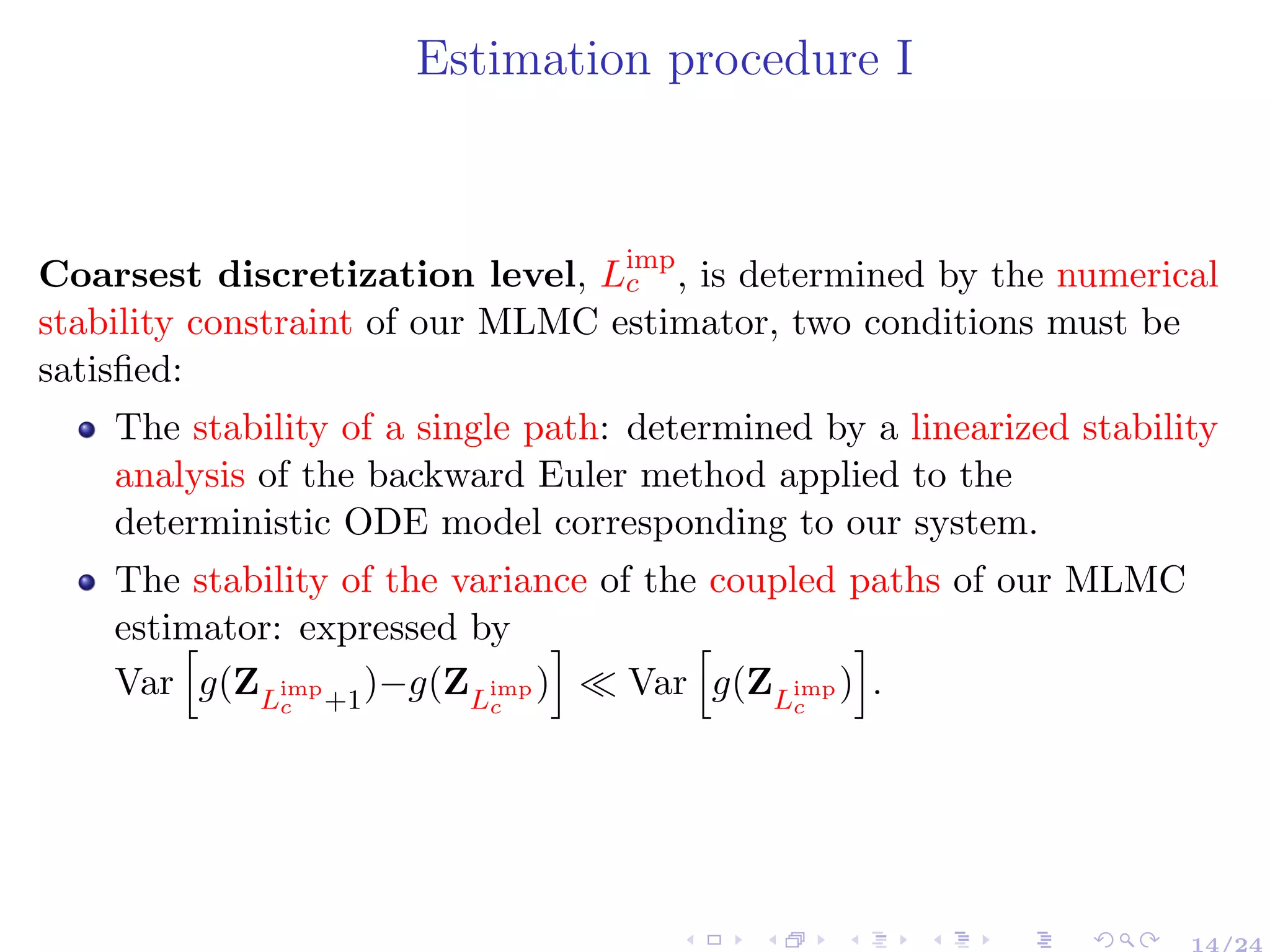

![Estimation procedure III
In our problem, the finest discretization level, L, is determined by
satisfying relation (11) for θ = 1
2, implying
|Bias(L) := E [g(X(T)) − g(ZL(T))]| <
TOL
2
. (13)
In our numerical experiments, we use the following approximation (see
[Giles, 2008])
Bias(L) ≈ E [g(ZL(T)) − g(ZL−1(T))] . (14)
16/24](https://image.slidesharecdn.com/mcqmctalk-190712144530/75/Mcqmc-talk-17-2048.jpg)
![Estimation procedure IV
The interface level, Lint and optimal number of samples per level, N
are determined by the following two steps:
1 The first step is to solve (15), for a fixed value of the interface level, Lint
min
N
WLint (N)
s.t. Cα
L
=Limp
c
N−1
V ≤ TOL
2 ,
(15)
where V = Var [g(Z (T)) − g(Z −1(T)] is estimated by the extrapolation
of the sample variances obtained from the coarsest levels (due to the
presence of large kurtosis.
2 Let us denote N∗(Lint) as the solution of (15). Then, the optimal value of
the switching parameter, Lint, should be chosen to minimize the expected
computational work; that is, the value Lint∗
that solves
min
Lint
WLint (N∗(Lint))
s.t. Lexp
c ≤ Lint ≤ L.
For this method, the lowest computational cost is achieved for
Lint∗
= Lexp
c , i.e., the same level in which the explicit-TL is stable.
17/24](https://image.slidesharecdn.com/mcqmctalk-190712144530/75/Mcqmc-talk-18-2048.jpg)
![Multilevel Hybrid SSI-TL: Results I
This example was studied in [Rathinam et al., 2003a] and is given by the
following reaction set
S1
c1
→ S3,
S3
c2
→ S1
S1 + S2
c3
→ S1 + S4. (16)
The corresponding propensity functions are
a1(X) = c1X1, a2(X) = c2(K − X1), a3(X) = c3X1X2.
where K = X1 + X3.
c = (c1, c2, c3) = (105, 105, 5 × 10−3), X(0) = (104, 102) and K = 2.104.
We are interested in approximating E [X2(T)], where T = 0.01 seconds.
This setting implies that the stability limit of the explicit-TL is
τlim
exp ≈ 10−5.
17/24](https://image.slidesharecdn.com/mcqmctalk-190712144530/75/Mcqmc-talk-19-2048.jpg)



![Summary
Our proposed estimator is useful in systems with the presence of
slow and fast timescales (stiff systems): obtained substantial gains
with respect to both the multilevel explit-TL
[Anderson and Higham, 2012].
For large values of TOL, the multilevel SSI-TL method has the
same order of computational work as does the multilevel explit-TL
method (O TOL−2 log(TOL)2 ) [Anderson et al., 2014], but with
a smaller constant.
21/24](https://image.slidesharecdn.com/mcqmctalk-190712144530/75/Mcqmc-talk-23-2048.jpg)
![Future work
Implementing Hybridization techniques involving methods that
deal with non-negativity of species [Moraes et al., 2015b] and
adaptive methods introduced in [Karlsson and Tempone, 2011,
Moraes et al., 2015a, Lester et al., 2015], which allows us to
construct adaptive hybrid multilevel estimators by switching
between SSI-TL, explicit-TL and exact SSA.
Extending the τ-ROCK method [Abdulle et al., 2010] to the
multilevel setting and compare it with the multilevel hybrid
SSI-TL method. The main challenge of this task is to couple two
consecutive paths based on the τ-ROCK method.
Addressing spatial inhomogeneities described, for instance, by
graphs and/or continuum volumes through the use of Multi-Index
Monte Carlo technology [Haji-Ali et al., 2015].
22/24](https://image.slidesharecdn.com/mcqmctalk-190712144530/75/Mcqmc-talk-24-2048.jpg)
